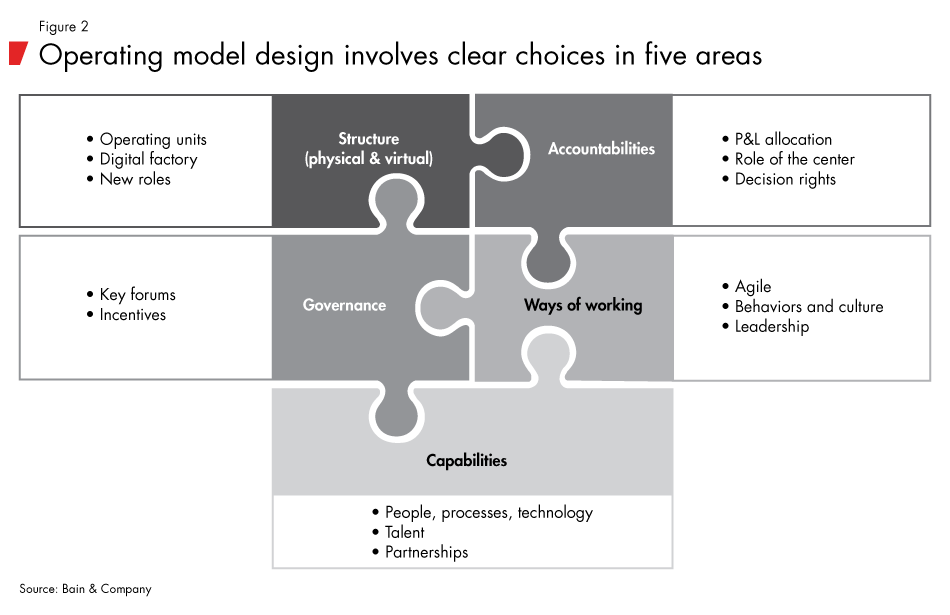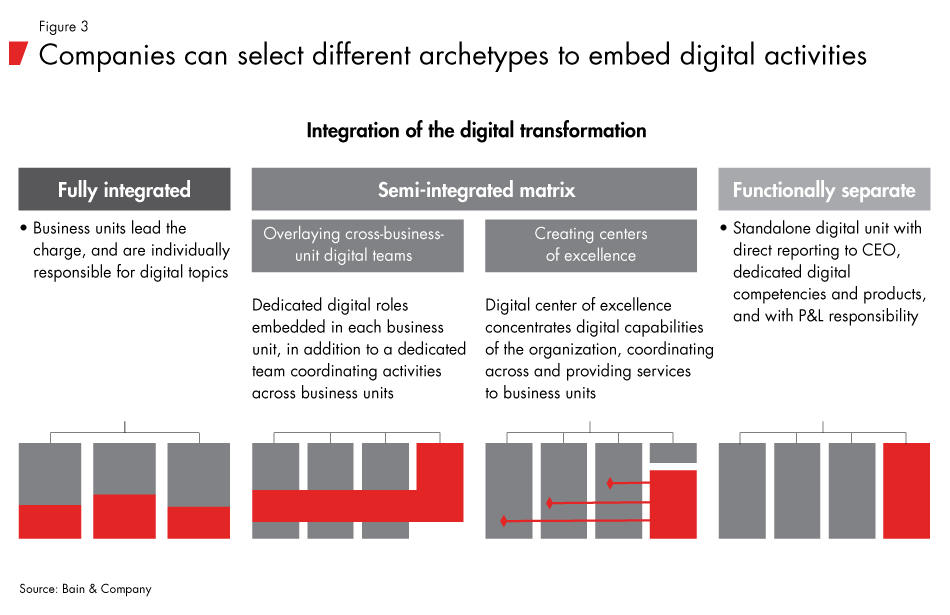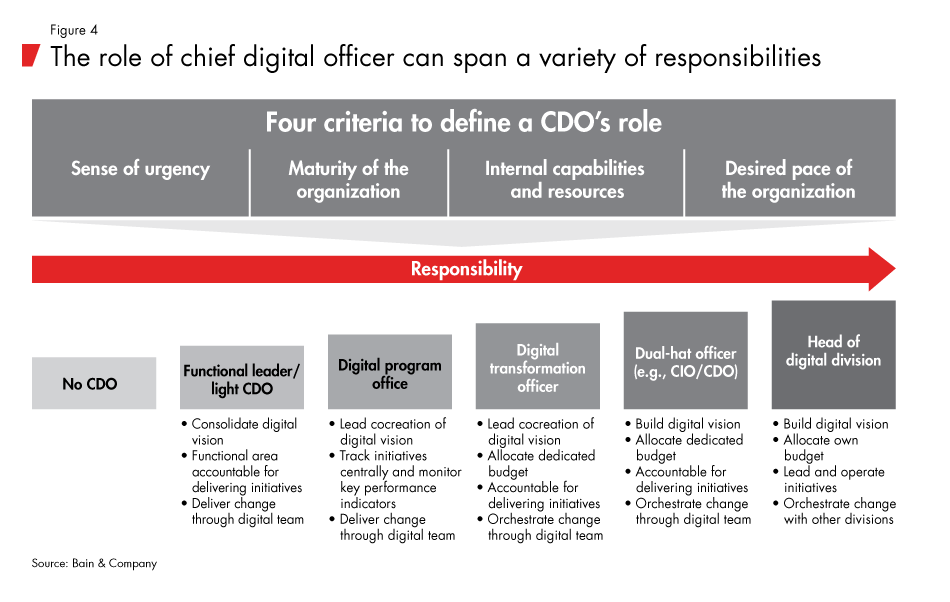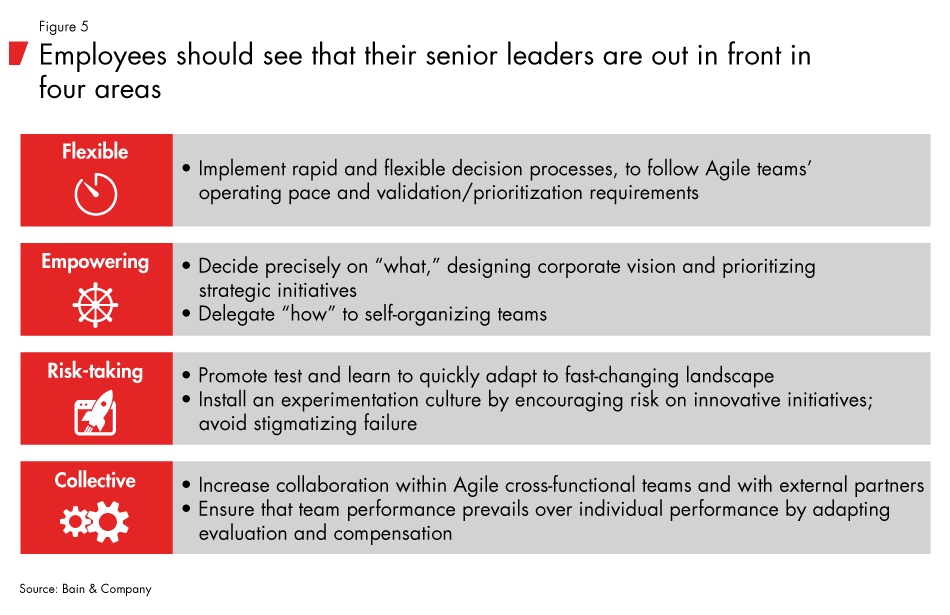Brief

Virtually all large companies, even those in old-line industries such as machinery and agriculture, have gone digital to some extent. But at many companies the efforts are falling far short of their potential. At one Asia-based conglomerate, for instance, digital initiatives have been popping up everywhere, and business units compete for the same digital talent. The company set up a digital incubator off to the side, but it has failed to spark interest with the mainstream divisions, and so creates great proofs of concept that never get embraced at large scale.
As digital continues to upend most business operations and markets, traditional organizations like this conglomerate struggle to cope with the pace of change. Breathless headlines and countless TED Talks suggest that executives should be asking "blow it all up" questions, such as:
- Does the concept of an "organizational structure" still make sense? Or should we move to self-organizing, manager-less teams?
- Should we scrap the idea of careers and employee loyalty in order to attract millennial talent for "tours of duty"?
- Do we really need any specialists in house, or should we do everything through partners in the ecosystem?
While digital clearly provokes change, most organizations do not need to make such drastic moves. The fundamental elements of an effective operating model remain as important as ever.
Rethinking the operating model
What makes the shift to more robust digital offerings, channels and operations so tricky is the stress it puts on old-line companies' operating models. Many new activities and capabilities—ranging from advanced analytics and rapid prototyping to cybersecurity and external partnership management—will need to be developed and located somewhere in the organization. Who takes ownership for these activities, who decides investment levels for each and how they will work are all major operating model questions.
In addressing these choices, companies usually start to realize that their legacy processes don't move fast enough to keep up with changing customer demands and behavior, which are shaped by digital interactions in other parts of their lives. Decision speed also may be too slow, because it's tied to budget cycles. Companies may find digital innovations hard to scale up beyond small projects. And certain kinds of digital talent have become very tough to source and hire.
As a result, digital transformations are significantly harder to pull off than conventional change programs. Bain & Company recently surveyed 1,000 companies around the world to gauge their level of digital readiness. After comparing financial results for five categories of companies based on their degree of digital sophistication, we found that revenues for the digital leaders grew 14% over the past three years, more than doubling the performance of the digital laggards in their industries. Profitability followed a similar pattern. Yet while the payoff from digital transformation can be impressively high, the success rate is regrettably low. In our survey, just 5% of those companies involved in digital transformation efforts reported that they had achieved or exceeded the expectations they had set for themselves (versus a success rate of 12% for conventional transformations found in an earlier survey). A full 71% of these companies settled for dilution of value and mediocre performance (see Figure 1).

Leading companies realize that making the transition to digital 2.0 or 3.0 requires systematically examining and adjusting each element of their operating model—the blueprint for how resources are organized and operated to get critical work done. The operating model encompasses decisions around the shape and size of the business, where to draw the boundaries for each line of business and function, how people work together within and across these boundaries, how the corporate center will add value to the business units, and what norms and behaviors should be encouraged. It entails choices in five areas (see Figure 2):
- Structure involves drawing appropriate boundaries for lines of business and functions, and defining centers of expertise and other coordinating units.
- Accountabilities describe the roles and responsibilities of the main organizational entities, including ownership for profit and loss statements and a clear, value-adding role for the corporate center.
- Governance refers to executive forums and management processes that yield high-quality decisions on strategic priorities, as well as budgets and incentives to align behavior.
- Capabilities refer to how the company combines people, process and technology in a repeatable way to deliver desired outcomes.
- Ways of working describe the expected cultural norms for how people collaborate, especially across the boundaries between functions or teams.
Executives should consider how each area will change in turn as the organization's digital intensity rises.

Structure: When should we integrate digital?
In most large firms, except for those that began as digital natives or in industries such as media that went digital early on, we still see more separate or semi-integrated digital units than digital being fully embedded into the mainstream of the organization. Companies generally started digital projects on a small scale and initially kept them off to the side. Now some of these initiatives have evolved or expanded to a point where they may be ready to integrate with other units.
No single structure works best for all companies. Some companies spread digital processes throughout their organizations from the start. Others created a standalone unit first to get it up and running. A middle ground that creates a digital center of excellence while also building some digital capabilities in business units or functions may be appropriate for other companies (see Figure 3).

To determine which structure suits their circumstances, executives should consider several dimensions:
- The level of disruption faced by the business. Firms facing a high degree of disruption tend to react too slowly if they entrust digital efforts to existing business units. That's why ABB, an industrial equipment and services company, had a digital team develop its Ability platform, while the business units provided the intelligence embedded within the platform.
- The level of digital maturity. The earlier a company is in its evolution, the more likely it is to need a bit of separation and autonomy for digital. The requisite skills are often distinct in digital, so when bringing in new talent such as data science experts, it's better to initially cluster them in a centralized group. More digitally mature companies, by contrast, generally have more integrated digital operations. For instance, retailers that years ago launched separate digital units, each with its own stock, assortment and website, have started wrapping those units back into the core business.
- The culture's openness to change. A relatively open culture can more easily pursue an integrated approach. Companies with a more resistant or slow culture will probably fare better with a separate unit or at least a central unit complementing the business units to ensure progress.
Even separate digital units, however, should link to the priorities of the business units and functions. Business units might have their own digital resources, but a separate entity could help coordinate across the units, or the business units could seek expert advice from the digital group about what their digital priorities should be. Without a connection back to the business units, a separate digital entity risks creating exciting proofs of concept that never get moved to the next stage.
A major specialty chemicals player, for instance, recently benchmarked its digital activities against its key competitors. Not only did its investments in digital lag behind the others, but the results from its spending lagged even more. Digital initiatives were scattered throughout the firm with little coordination, leading to redundant efforts that rarely got scaled up. After a thorough analysis and ample debate among the senior executive team, the company is establishing a digital unit in a "protected start-up" form. That will make it easier to protect resources from other demands that might have a higher return on investment (ROI) in the short term, and also easier to attract digitally savvy talent. To prevent the unit from becoming an ivory tower, about half of its staff will be distributed across regional digital units, reporting to and responding to the priorities of the respective regional business heads, with dotted-line reporting to the global digital unit.
Structures may change quickly. For most companies, having some dedicated focus through a separate or semi-integrated digital unit makes sense early on—but probably not over the longer term. A good digital group could even render itself unnecessary, once their mission is accomplished and all functions and businesses have integrated digital into their activities. Companies should periodically verify whether they need a chief digital officer (CDO) role, or whether those duties will be better wrapped into existing chief information officer or chief technology officer roles.
Accountabilities: Who makes decisions?
With most digital activities requiring the involvement of several different functions or units, there’s a premium on the "software" of strong accountabilities, rather than the "hardware" of reporting lines. In retailing, for instance, the store, merchandising, planning and marketing units all must work with the e-commerce unit to ensure that online and offline inventory are fully integrated.
Digital may also alter decision rights and the role of the corporate center, which might take on activities that were once done in a distributed fashion. At Media Saturn, Europe's largest electronics retailer, store managers for the banners MediaMarkt and Saturn were quite entrepreneurial, making choices about pricing and assortment for their stores. After the company launched its e-commerce platform, it became clear that the banners needed more consistency of pricing and assortment across channels. Media Saturn decided on a greater role in those areas for the center, in order to harness the big data and advanced analytics for predicting which products will sell best in each channel. Store managers now can offer different pricing to move certain products—but only lower pricing than online. And they must carry a core assortment of products, though they can adjust the mix outside that core. Their role has evolved to focus more on creating a great customer experience.
In other cases, though, digital might move activities in the opposite direction, enabling more decentralization, within guardrails, than has been possible in the past.
The ways in which a CDO will take accountability for decisions can vary widely across organizations (see Figure 4). In almost all cases, the CDO plays a role in setting the digital vision and keeping tabs on digital activities across the company. Some companies that wish to move quickly give the CDO a more prominent role in a few critical areas, such as funding—decisions on whether and how much to invest. If these decisions are left to the business units, a company will probably get subscale investment.

Some decisions, however, will require the CEO to set the tone and stretch the organization. The CEO of a major industrial pump company determined that within one year all products should be equipped with sensors providing monitoring data. He knew there could be quality issues with between 5% and 10% of pumps, but decided to take that risk in order to accelerate digitalization of the installed base and company's ability to use the data to provide monitoring services. A year later, the company has started to offer such services.
Governance: Can we tame the multiheaded Hydra?
Orchestrating and steering various digital actions effectively across the organization may require adjustments to governance. A digital council composed of business unit heads and key functional heads can serve as the forum for debate and consensus.
A council or similar body can also resolve questions of how to pay for digital innovations. One supplier of agricultural commodities developed a mobile application for its field sales force in one line of business. It then added features that made it useful for field forces in other crops. As the company keeps adding features to make the app relevant to more products, it has been charging an internal licensing fee, as it would to pay an external software-as-a-service vendor. That ran into resistance from some executives of the business units, who run their own P&Ls. The company's dilemma: Charging an internal license fee could slow the rate of adoption, but without a fee, who would pay for the innovation? The executive team decided that the app is strategically important and therefore should be centrally funded.
Capabilities: Where should we double down?
Expanding the digital arsenal inevitably entails identifying which new capabilities the company needs and which existing capabilities require an upgrade. The key questions companies wrestle with here are how to source these capabilities and whether to build them in-house at all.
Sometimes companies need to retrain existing employees, as when their roles still require many of the existing skills but now need to add new digital variants. For example, a food service business selling to a hospital will have to understand the facilities manager's priorities, the physical processes in the cafeterias and the preferences of guests, which of course are skills relevant even before digital variants; now they also must learn what digital tools are available to ease pain points and improve the selection of items on the shelves. Only the collective knowledge of employees can develop an integrated proposition the facilities manager will value. In this case, training on the specific tools and approaches, and getting the employees to use the tools in real settings right away, is more effective than lengthy classroom sessions.
In other situations, companies will have to tap pools of new people. Hiring is one option but has its own challenges, which is why industrial companies often locate their digital centers in Silicon Valley or Berlin rather than in industrial heartlands.
Sometimes large companies will acquire a stake in a start-up as a means of getting access to the staff. UK retailer John Lewis runs an incubation program for tech-focused start-ups, providing mentors and free office space in John Lewis headquarters. Start-ups that win a slot can also apply for funding of up to £100,000 in return for a share in their company. One participant was Localz, an Australian beacon business that can tell retailers when a customer has walked into a store based on the person's phone signal. After testing the technology, John Lewis incorporated the technology into its click-and-collect service.
Finally, many companies choose to develop capabilities through partnerships. They open themselves to an external ecosystem of digital specialists, in order to take advantage of other firms' expertise and investments in assets (such as cloud infrastructure or analytics engines), which are hard to build internally. For example, DMG MORI, Dürr, Software AG and Zeiss have joined forces to establish an open Industrial Internet of Things platform, called Adamos. The partnership aims to reduce machine builders' development costs by making centrally developed solutions and services available. Of course, working with a group of external partners can be a challenge for companies that might not have a history of strong collaboration even among internal units. Partnership management thus is itself a key capability that will require coaching for the relevant managers.
Ways of working: Will our old dogs learn new tricks?
Companies that outperform along economic dimensions say that new ways of working are the most important element of their success in digital endeavors, a recent survey by Bain & Company reports. Ways of working should support faster cycle times for projects, greater connectedness among different functions and units, and more external engagement with customers and partners.
Like any new endeavor, experience trumps theory, so it's critical to rapidly involve teams in real digital projects. Put people in situations where they can design, manipulate and test digital features, whether by using a robot in a manufacturing process or rolling out handheld devices at a hotel front desk. Teams will learn and advance to release 2.0, 3.0 and so on—all the while creating a wider circle of digital believers.
Involving the heads of business units early on will help to ensure strong sponsorship for an accelerated process (see Figure 5). The supplier of agricultural commodities mentioned earlier has successfully run a number of digital pilot projects, but when it came time to scale up the projects, some got delayed inside the business units—often for good reasons. For a new digital inventory tracking system that would replace manual entry of bags of one commodity, the warehouse operating teams had many ideas to improve the system. Cost-conscious managers also balked at paying for a high-end handheld scanner when a cheaper one would do. The company learned that involving the head of a business unit from the start, so that he or she can socialize the initiative with the operating team, helps to hash out the operational details faster and more efficiently.

Shifting to new Agile methods, and not just in software development, can accelerate the process of thinking and behaving differently. A good place to embed Agile first is in digital product development, where getting feedback quickly is essential, and in markets where competitors clearly are causing disruption. Cross-functional Agile teams proceed through a series of short-cycle, minimum-viable products, each tested with customers (including internal customers) and then incrementally improved. Later, a company can field a set of scale-up teams that help to bridge the innovating teams with those who will have to execute innovations in the field. One US restaurant chain uses Agile teams to generate innovations, but relies on store managers to execute the innovations; the company introduced a scale-up team to create a release plan for each innovation.
The relentless rise of digital technology in customers' expectations and competitors' operations brooks no delay for companies that lag or for leaders seeking to keep their edge. And the strength of a company's operating model determines success or failure. Digital innovation happens so quickly that the ability of the organization to formulate, implement and scale up a strategy has become more important than the exact strategy chosen at any single point in time. So while some headlines may herald the end of the organization, the concept of the operating model endures as a useful guide for executives to make smart digital investments—and get them to stick.
Jenny Davis-Peccoud leads Bain & Company's Organization practice in Europe, the Middle East and Africa. Laurent-Pierre Baculard leads Bain's Digital practice in Europe, the Middle East and Africa. Greg Caimi leads the Digital practice in the Americas. Oliver Straehle is a partner in the Industrial Goods & Services practice. The authors are based, respectively, in London, Paris, San Francisco and Zurich.